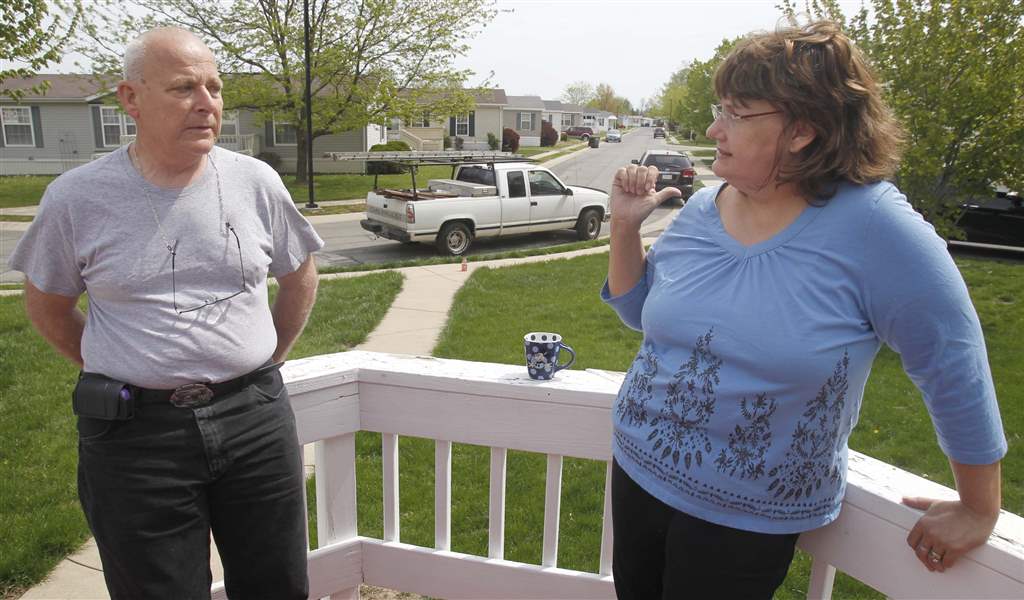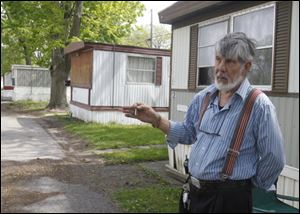
Tornado shelters on council agenda
Mobile-home parks lack refuge
4/23/2012
Charles Grasser and Marian Parkins, residents of the Westbrook mobile-home park in South Toledo, discuss the lack of shelters.
The Blade/Lori King
Buy This Image

Charles Grasser and Marian Parkins, residents of the Westbrook mobile-home park in South Toledo, discuss the lack of shelters.
Mimi Grasser’s tornado-safety plan is simple but hardly fool-proof.
“Pray,” stated the 71-year-old resident of Westbrook mobile-home park in South Toledo when asked what she does during a tornado alert.
Like many mobile-home residents in Toledo and other parts of the country, she has no place to go to quickly to take shelter when a tornado siren sounds or a tornado watch or warning is issued.
Mobile homes are notoriously unsafe during severe weather, but in Ohio, mobile-home parks don’t have to provide tornado shelters for their residents, according to the state’s department of health.
Toledo City Council plans to hold a committee hearing today to discuss the challenges mobile-home residents face during a tornado alert. Councilman D. Michael Collins, who organized the hearing, said he will push officials to develop a city-county plan for access to shelters.
He said he hopes to form a committee that will look at ways to finance the construction of shelters or create a list of shelter options for people living in manufactured homes.
Mr. Collins said he became aware of the issue after the deadly tornado that swept through Wood County two years ago, killing seven people, and from comments made by residents at community block-watch meetings.
He said tornado warnings and alerts are only the first part of trying to ensure safety during a severe storm.
“We go out, we turn the sirens on. That’s fine. But the next question comes in: ‘OK, I’ll do what you told me.’ But then you say, ‘Where do I go?’?” Mr. Collins said. “Don’t just tell them that they have to exit their home, but we don’t know where they should go.”
Tornadoes are a threat to people inside many kinds of buildings. But Greg Carbin, a warning coordination meteorologist for the National Oceanic and Atmospheric Administration, said mobile-home residents are disproportionately represented among U.S. tornado fatalities. This year alone, of 63 deaths from tornadoes across the country, 47 were of people inside or fleeing mobile homes.
“They’re not very sound structures for the most part. They don’t bear wind load very much,” Mr. Carbin explained. “If you live in a mobile home, you’re at significant risk of injury or death because the wind will pick those up pretty easily.”
According to the Lucas County auditor’s office, Toledo has 28 mobile-home parks and 1,426 mobile homes in total.

At the Creekside Mobile Home Park off the Anthony Wayne Trail, 66-year-old Alvin Kinsinger says he doesn’t even try to find shelter during a tornado alert.
Joe Walter, the emergency management agency director for Lucas County, said he does not keep track of which parks have shelters, but from experience he doubts that many do.
He said he would like for parks to provide tornado shelters for their residents, but there is no legal way to make that happen.
At Westbrook on Angola Road, block-watch leader Marian Parkins is well aware of the difficulties in trying to find shelter.
She’s been through five tornado warnings since she moved to the park eight years ago, and each time she attempted to find shelter with her family, she ended up in despair, she said.
On three occasions, Ms. Parkins said, she went to a nearby fire station only to find it closed.
During the 2010 storm that produced the deadly tornado in Wood County, she attempted to drive to her brother’s house only to find that the road outside the park had been flooded by the rain.
She said it took 45 minutes to reach her brother’s house by a different route, even though it’s only a couple of miles away.
“My husband said: ‘We’re going to get killed before we even get there,’” she recalled.
Other residents have attempted to take shelter at a nearby Walmart but were told they would have to leave after the lights went out, Ms. Parkins said.
Springfield Township last year formed a safety partnership program that established two shelters at Springfield schools where area residents can take cover from severe weather.
Ms. Parkins and other Westbrook residents said that’s a good start, but both locations are several minutes away and trains at railroad crossings could hold them up in an emergency. “I wish there was something closer, something in the park,” Ms. Parkins said.
Across town, at the Creekside Mobile Home Park off the Anthony Wayne Trail near downtown, 66-year-old Alvin Kinsinger said he doesn’t even try to find shelter during a tornado alert.
He said residents formerly were allowed to go inside a laundry room during a severe storm but the door is now locked because of fear that someone will steal the washing machines.
“So now, if a tornado comes through here, you’d better go do something like jump in the creek,” Ms. Kinsinger said, pointing to Swan Creek, which runs behind the trailer park. “But there’s no plan to speak of.”
Mr. Walter, the emergency management official, said federal guidelines for tornado shelters, which he calls “safe rooms,” are that they be within five minutes’ walking distance or half-mile driving distance, he said. The Federal Emergency Management Agency offers grants to communities to build these structures, but they are hard to get, he said.
What residents can do, however, is make sure they have a plan in place before a tornado strikes.
He said the time to seek shelter is when the National Weather Service issues a tornado watch, which means conditions are ripe for tornadoes to form. If people attempt to find shelter after a tornado warning — which means a tornado has been seen — it could be too late, he said.
“They need to be aware that they’re in a high-risk area. They need to be thinking about a plan as to what they’re going to do,” the director said. “They need to have a plan to go some place.”
Contact Claudia Boyd-Barrett at cbarrett@theblade.com or 419-724-6272.